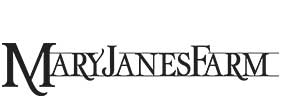| Natural woman Lewiston Morning Tribune, December 2001 |
|
|
Palouse's homespun version of Martha Stewart
branches out with a new magazine/catalog The goal is simple. "I want to feed people," she says. But over the last 10 years, the details have put Butters' mark on the organic food world. Her latest venture — what she calls "one part catalog, two parts women's magazine"— is a slick, 115-page publication called MaryJanesFarm. It features quick-preparation, albeit somewhat pricey, organic food for ordering and also has feature stories on country living, plus do-it-yourself, gardening and energy-saving tips. Much of the written content is submitted by people throughout the region. "I know myself and my women friends and what we talk about on the phone and in e-mail," Butters says. "Why not create a place where we can all talk? "And it's working." Butters, a voracious reader with subscriptions to 50 magazines, started thinking about making her own color catalog last winter. She developed the idea in her mind and hired two local graphic designers to help bring it to fruition. Butters thought the venture would take a few months to complete. But nearly a year and $30,000 later, MaryJanesFarm is the newest addition to Butters' growing empire that includes organic backpacking food and Paradise Farm Organics Inc. She says the organic instant meals for backpacking marked the point
where she finally became successful by finding a niche market and gaining
consistent sales. "I thought about what else I could do with food, and I really want people cooking at home." Thus, the magazine. Five thousand copies of the publication, which Butters says is like nothing she has ever read, were printed in Spokane by Lawton Printing. Nearly all of the editorial staff is from the Palouse. Hiring an outside magazine company to develop and produce her idea could have cost $1 million, she says. Butters does not sell subscriptions to the publication. The first copy is free and readers who buy $50 worth of food get a year's worth of magazines. "You get a subscription and food. How can you go wrong?" How many magazines a subscription entails, Butters doesn't know. The magazine is published "periodically," Butters says. "Seasonally. Whensoever possible," she amends. She would like to publish four times a year, but since there are no advertisements ("I hate ads") and the publication is part catalog, there is no pressure to maintain a regular schedule. "I sort of just did something from my head to see if it would work. When I took it to the press, I didn't exhale for a week." Positive feedback has poured into her office and bookstores have requested magazine signings. One notable feature of the first issue is Butters' picture, which graces the front, inside and back covers. Having her picture throughout the magazine helps to form a relationship with readers, Butter says. "You can put a face to a name. You can trust me." Butters knows she is branding herself and says because there is a real person behind the picture, it creates a bond with her customers. "In the business world, that's worth a lot." But Butters isn't taking the lead of Oprah and putting herself on the cover of every issue. She sent one unsolicited copy of the magazine to the media mogul, but has not heard back. Along with Butters, Moscow and the Palouse are highlighted often in the magazine. Butters says she wants Moscow to become the nerve center for organic food in the country. The magazine is her latest accomplishment, but Butters says she has a list of ideas and projects to tackle. These include an adopt-an-acre program for people to sponsor an acre of farmland if farmers promise not to use chemicals on the soil. She wants to expand her Pay Dirt Farm School, where people work on her farm in exchange for learning different work skills. Despite her mountain of ideas and energy, Butters knows not to expect too much too soon. "Change has humble beginnings," she says. She also knows failure is part of life and overcoming obstacles takes patience. "It's not that I haven't made a million mistakes and overdrawn my checking account a million times. But my personality is such that I keep getting up." Those who want to order a copy of the magazine may call (888) 750-6004. Butters says she will not sell her mailing list or buy any others. Readers can request copies sent to friends or family and Butters will include a sticky note in the magazine telling who asked the magazine be sent. |
Life and times of MaryJane Butters
|


